

|
| POLSKA | POLAND |
| województwo: Wielkopolskie | voivodship: Greater Poland (Posnania) |
| miasto na prawach powiatu: Poznań | city: Poznań |
Poznań, the capital of the Polish voivodship Greater Poland, is situated at an elevation of 60 m at the Warta river. At a population of about 544,600 (2015) it is Poland's 5th largest city and the 4th biggest industrial centre of the country.
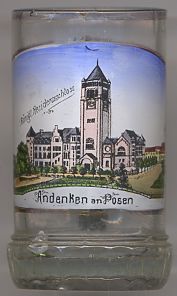 Mieszko I, the first known duke of the Polans, built one of his castles in Poznań The Cathedral Basilica of St. Peter and St. Paul is the oldest Polish cathedral,
founded in Poznań during the latter half of the 10th century. The city would become the capital of Greater Poland. Mieszko's son, Bolesław I ('the Brave'), was crowned
king in 1025 and the kingdom of Poland was formed. Greater Poland became the 'cradle of the Polish state', and both Mieszko I and Bolesław I are buried in Poznań.
Poznań (in German: Posen) was the capital of the Greater Poland area when it came under the control of Prussia in 1793 and had its administrative area renamed to
South Prussia. During the Greater Poland Uprising of 1806, local Polish resistance fighters rebelled, thereby assisting the efforts of Napoleon while simultaneously driving
out the occupying Prussian forces. The city became part of the Duchy of Warsaw in 1807 (see map) and was capital of the Poznań department.
Napoleon's defeat led to the Congress of Vienna (1815), where the boundaries of Europe were redrawn by the victors. Greater Poland was returned to
Prussia and became the capital of the autonomous Grand Duchy of Posen (see map). From the time of the Revolutions in the mid 1800s, it was an official Prussian province and became part
of the German Empire after the unification of German states in 1871. Shorty after Germany's defeat in World War I, the Great Poland Uprising (1918–1919) occurred,
leading to the creation of the Second Polish Republic, where Poznań became the capital of Poznań Voivodeship. During World War II, the Polish population was
severely repressed by the Nazi occupation forces. Since the war's end, Poznań has become the capital of the surrounding area through administrative district boundary
changes in 1957, 1975, and 1999. Poznań currently administrates Greater Poland Voivodeship, one of 16 provinces in the country. The Poznań riots of 1956 played a
significant role in liberalising the post war communist regime.
Mieszko I, the first known duke of the Polans, built one of his castles in Poznań The Cathedral Basilica of St. Peter and St. Paul is the oldest Polish cathedral,
founded in Poznań during the latter half of the 10th century. The city would become the capital of Greater Poland. Mieszko's son, Bolesław I ('the Brave'), was crowned
king in 1025 and the kingdom of Poland was formed. Greater Poland became the 'cradle of the Polish state', and both Mieszko I and Bolesław I are buried in Poznań.
Poznań (in German: Posen) was the capital of the Greater Poland area when it came under the control of Prussia in 1793 and had its administrative area renamed to
South Prussia. During the Greater Poland Uprising of 1806, local Polish resistance fighters rebelled, thereby assisting the efforts of Napoleon while simultaneously driving
out the occupying Prussian forces. The city became part of the Duchy of Warsaw in 1807 (see map) and was capital of the Poznań department.
Napoleon's defeat led to the Congress of Vienna (1815), where the boundaries of Europe were redrawn by the victors. Greater Poland was returned to
Prussia and became the capital of the autonomous Grand Duchy of Posen (see map). From the time of the Revolutions in the mid 1800s, it was an official Prussian province and became part
of the German Empire after the unification of German states in 1871. Shorty after Germany's defeat in World War I, the Great Poland Uprising (1918–1919) occurred,
leading to the creation of the Second Polish Republic, where Poznań became the capital of Poznań Voivodeship. During World War II, the Polish population was
severely repressed by the Nazi occupation forces. Since the war's end, Poznań has become the capital of the surrounding area through administrative district boundary
changes in 1957, 1975, and 1999. Poznań currently administrates Greater Poland Voivodeship, one of 16 provinces in the country. The Poznań riots of 1956 played a
significant role in liberalising the post war communist regime.
The  residence castle [left] in Romanesque revival style was built in 1905–1910 for German Emperor Wilhelm II,
King of Prussia. However, the emperor only visited the castle once, in 1913. During the Second Polish Republic it was used by the Ministry for the former Prussian territories
and temporarily also was home of a museum for ecclesiastical art. During World War II the castle was used as the office of the Gauleiter for the Warthegau.
After World War II the building was at first used by the city administration of Poznań and today is home of the culture centre "Zamek" ('Castle').
residence castle [left] in Romanesque revival style was built in 1905–1910 for German Emperor Wilhelm II,
King of Prussia. However, the emperor only visited the castle once, in 1913. During the Second Polish Republic it was used by the Ministry for the former Prussian territories
and temporarily also was home of a museum for ecclesiastical art. During World War II the castle was used as the office of the Gauleiter for the Warthegau.
After World War II the building was at first used by the city administration of Poznań and today is home of the culture centre "Zamek" ('Castle').
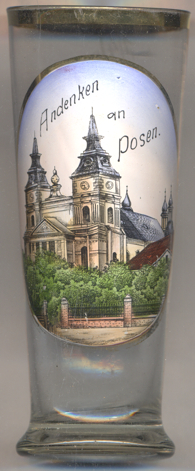
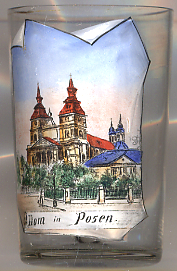
The  Archcathedral Basilica of St. Peter and St. Paul
[left, no. 3273, and right, no. 2938] is one of the oldest churches in Poland and the oldest
Polish cathedral, dating from the 10th century. The cathedral was originally built in the second half of the
10th century, it was raised to the status of a cathedral in 968. Saint Peter became the patron of the church because,
as the first cathedral in the country, it had the right to have the same patron as St. Peter's Basilica in the
Vatican. The pre-Romanesque church which was built at that time was about 48 meters in length.
Remains of this building are still visible in the basements of today's basilica. The first church survived for about seventy
years, until the period of the pagan reaction and the raid of the Bohemian duke Břetislav I (1034–1038).
The cathedral was rebuilt in the Romanesque style, remains of which are visible in the southern tower. In the 14th and 15th
centuries, the church was rebuilt in the Gothic style. At that time, a crown of chapels was added. A fire in 1622 did such
serious damage that the cathedral needed a complete renovation, which was carried out in the Baroque style. Another major
fire broke out in 1772 and the church was rebuilt in the Neo-Classical style (this is the church depicted on glass
no. 2938, [left]). In 1821, Pope Pius VII raised the cathedral to the status of a Metropolitan
Archcathedral and added the second patron, Saint Paul. The last of the great fires occurred on 15 February 1945, during
the liberation of the city from the Germans. The damage was serious enough that the conservators decided to return to the
Gothic style, using as a base medieval relics revealed by the fire. The cathedral was reopened on 29 June 1956. In 1962,
Pope John XXIII gave the church the title of Basilica minor.
Archcathedral Basilica of St. Peter and St. Paul
[left, no. 3273, and right, no. 2938] is one of the oldest churches in Poland and the oldest
Polish cathedral, dating from the 10th century. The cathedral was originally built in the second half of the
10th century, it was raised to the status of a cathedral in 968. Saint Peter became the patron of the church because,
as the first cathedral in the country, it had the right to have the same patron as St. Peter's Basilica in the
Vatican. The pre-Romanesque church which was built at that time was about 48 meters in length.
Remains of this building are still visible in the basements of today's basilica. The first church survived for about seventy
years, until the period of the pagan reaction and the raid of the Bohemian duke Břetislav I (1034–1038).
The cathedral was rebuilt in the Romanesque style, remains of which are visible in the southern tower. In the 14th and 15th
centuries, the church was rebuilt in the Gothic style. At that time, a crown of chapels was added. A fire in 1622 did such
serious damage that the cathedral needed a complete renovation, which was carried out in the Baroque style. Another major
fire broke out in 1772 and the church was rebuilt in the Neo-Classical style (this is the church depicted on glass
no. 2938, [left]). In 1821, Pope Pius VII raised the cathedral to the status of a Metropolitan
Archcathedral and added the second patron, Saint Paul. The last of the great fires occurred on 15 February 1945, during
the liberation of the city from the Germans. The damage was serious enough that the conservators decided to return to the
Gothic style, using as a base medieval relics revealed by the fire. The cathedral was reopened on 29 June 1956. In 1962,
Pope John XXIII gave the church the title of Basilica minor.
(see also list of other basilicae minores depicted on glasses of this collection)
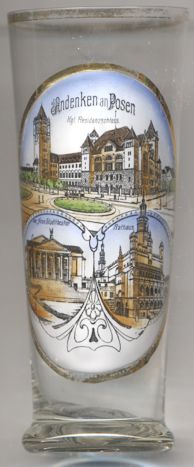
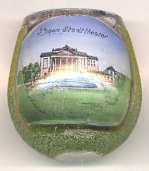
The  Grand Theatre [near left, no. 4567: bottom left picture, and right, no. 2814]
was built in 1910 by the German architect Max Littmann, at the time under the German name Neues Stadttheater (New Municipal Theatre).
Since 1949 it is named after the Polish composer Stanisław Moniuszko, Teatr Wielki im. Stanisława Moniuszki w Poznaniu.
Grand Theatre [near left, no. 4567: bottom left picture, and right, no. 2814]
was built in 1910 by the German architect Max Littmann, at the time under the German name Neues Stadttheater (New Municipal Theatre).
Since 1949 it is named after the Polish composer Stanisław Moniuszko, Teatr Wielki im. Stanisława Moniuszki w Poznaniu.
The historic  Town Hall [near left, no. 4567: bottom right picture]
is located in the old town in the centre of the Old Market Square. It used to serve as the seat of local government until 1939, and now houses
a museum. The town hall was originally built in the late 13th century following the founding of the medieval city in 1253. It was rebuilt
in roughly its present-day form, in Mannerist style, with an ornate loggia, by Giovanni Battista di Quadro in 1550–1560. The display of
mechanical fighting goats, played out daily at noon above the clock on the front wall of the building, is one of the city's main tourist attractions.
Town Hall [near left, no. 4567: bottom right picture]
is located in the old town in the centre of the Old Market Square. It used to serve as the seat of local government until 1939, and now houses
a museum. The town hall was originally built in the late 13th century following the founding of the medieval city in 1253. It was rebuilt
in roughly its present-day form, in Mannerist style, with an ornate loggia, by Giovanni Battista di Quadro in 1550–1560. The display of
mechanical fighting goats, played out daily at noon above the clock on the front wall of the building, is one of the city's main tourist attractions.
[https://de.wikipedia.org/wiki/Poznań, http://en.wikipedia.org/wiki/Poznań;
https://en.wikipedia.org/wiki/Poznań_Cathedral;
https://de.wikipedia.org/wiki/Rathaus_(Posen);
https://en.wikipedia.org/wiki/Pozna%C5%84_Town_Hall]
![[scale]](lineal.jpg)